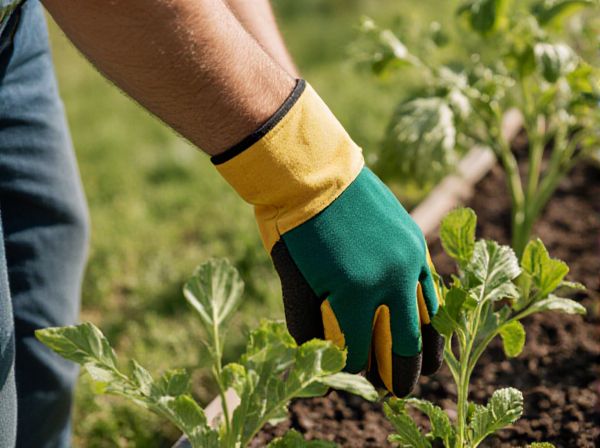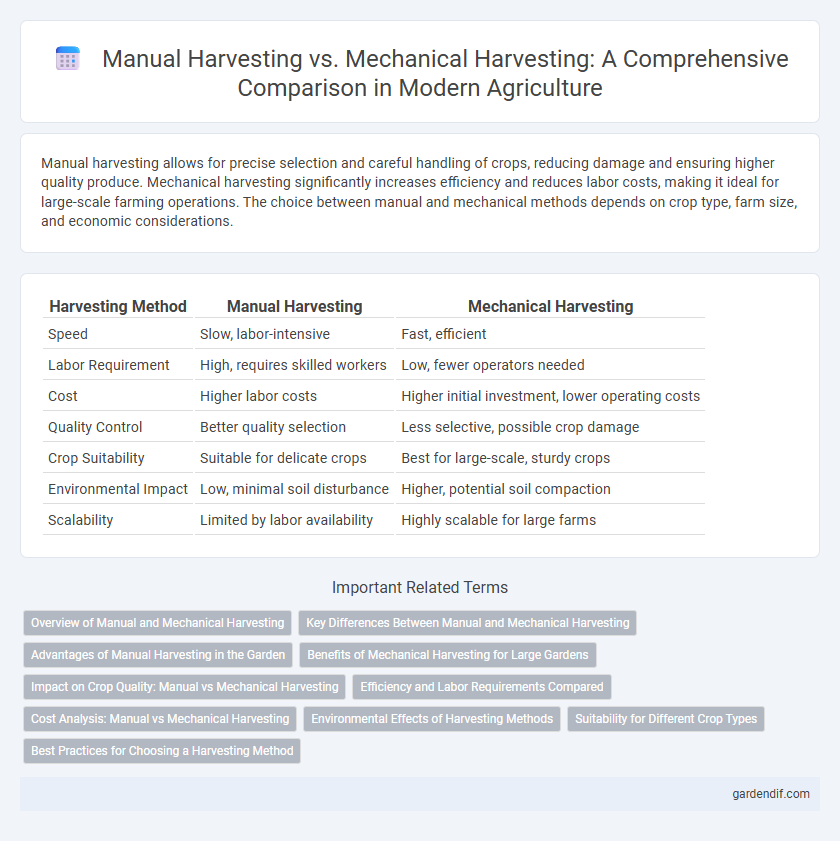
Manual Harvesting vs Mechanical Harvesting Illustration
Manual harvesting allows for precise selection and careful handling of crops, reducing damage and ensuring higher quality produce. Mechanical harvesting significantly increases efficiency and reduces labor costs, making it ideal for large-scale farming operations. The choice between manual and mechanical methods depends on crop type, farm size, and economic considerations.
Table of Comparison
| Harvesting Method | Manual Harvesting | Mechanical Harvesting |
|---|---|---|
| Speed | Slow, labor-intensive | Fast, efficient |
| Labor Requirement | High, requires skilled workers | Low, fewer operators needed |
| Cost | Higher labor costs | Higher initial investment, lower operating costs |
| Quality Control | Better quality selection | Less selective, possible crop damage |
| Crop Suitability | Suitable for delicate crops | Best for large-scale, sturdy crops |
| Environmental Impact | Low, minimal soil disturbance | Higher, potential soil compaction |
| Scalability | Limited by labor availability | Highly scalable for large farms |
Overview of Manual and Mechanical Harvesting
Manual harvesting involves labor-intensive methods where workers handpick crops, allowing precise selection and minimal damage, ideal for delicate fruits and vegetables. Mechanical harvesting uses specialized machinery to efficiently gather large quantities of crops, significantly reducing labor costs and time but potentially causing more damage to produce. Choosing between manual and mechanical harvesting depends on crop type, field size, cost considerations, and desired quality outcomes.
Key Differences Between Manual and Mechanical Harvesting
Manual harvesting involves skilled laborers picking crops by hand, ensuring careful selection and reduced damage to delicate produce, suitable for small-scale farms and high-value crops. Mechanical harvesting uses specialized machines like combine harvesters, significantly increasing efficiency and speed, ideal for large-scale operations and crops like wheat and corn. Key differences include labor intensity, cost, harvest speed, and crop suitability, with manual methods offering precision and mechanical methods providing volume and time savings.
Advantages of Manual Harvesting in the Garden
Manual harvesting in the garden provides precise selection of ripe fruits and vegetables, ensuring higher quality and reducing damage compared to mechanical methods. It allows for careful handling of delicate crops, preserving their texture and appearance while minimizing waste. Additionally, manual harvesting supports sustainable practices by reducing soil compaction and machinery fuel consumption.
Benefits of Mechanical Harvesting for Large Gardens
Mechanical harvesting significantly increases efficiency and reduces labor costs in large gardens by quickly collecting crops with specialized machinery. It ensures uniformity and minimizes crop damage, enhancing overall yield quality and consistency. The technology also allows for timely harvesting, crucial for maintaining optimal freshness and market value in bulk production.
Impact on Crop Quality: Manual vs Mechanical Harvesting
Manual harvesting preserves crop quality by allowing selective picking, minimizing damage to fruits and vegetables and reducing bruising or contamination. Mechanical harvesting increases efficiency but can cause higher crop damage rates due to rough handling and less precise selection, potentially compromising the shelf life and market value. The choice between manual and mechanical harvesting significantly affects post-harvest quality and consumer satisfaction.
Efficiency and Labor Requirements Compared
Manual harvesting requires significant labor input, with workers handpicking crops, which ensures careful handling but limits speed and scale. Mechanical harvesting uses advanced machinery to cover large areas quickly, drastically improving efficiency and reducing the need for manual labor. Despite high upfront costs, mechanical methods optimize labor requirements and accelerate processing time in large-scale farming operations.
Cost Analysis: Manual vs Mechanical Harvesting
Manual harvesting incurs higher labor costs due to intensive human involvement and longer harvest durations, making it less economical for large-scale farms. Mechanical harvesting requires significant upfront investment in machinery but lowers long-term labor expenses and increases operational efficiency. Cost analysis reveals that mechanical harvesting becomes more cost-effective as farm size increases, offsetting initial capital expenditure through improved productivity and reduced labor wages.
Environmental Effects of Harvesting Methods
Manual harvesting minimizes soil compaction and preserves biodiversity by limiting disturbances to the surrounding environment, promoting healthier ecosystems. Mechanical harvesting increases efficiency but can lead to soil erosion, habitat destruction, and higher carbon emissions due to heavy machinery use. Implementing sustainable mechanical practices and combining them with manual methods can reduce environmental impacts while optimizing productivity.
Suitability for Different Crop Types
Manual harvesting remains highly suitable for delicate crops like fruits, vegetables, and specialty herbs that require careful handling to prevent damage. Mechanical harvesting excels in large-scale cultivation of grains, corn, and root crops, where efficiency and speed are critical, but may cause damage to more fragile produce. Selection of harvesting methods depends heavily on crop type, scale of operation, and quality requirements to optimize yield and product integrity.
Best Practices for Choosing a Harvesting Method
Manual harvesting ensures precise selection and minimal crop damage, ideal for delicate fruits and small-scale farms where labor availability is high. Mechanical harvesting increases efficiency and reduces labor costs, suitable for large-scale operations with uniform crops like grains and certain vegetables. Evaluating crop type, field size, labor resources, and budget constraints helps determine the optimal harvesting method to maximize yield and quality.
Manual Harvesting vs Mechanical Harvesting Infographic

 gardendif.com
gardendif.com